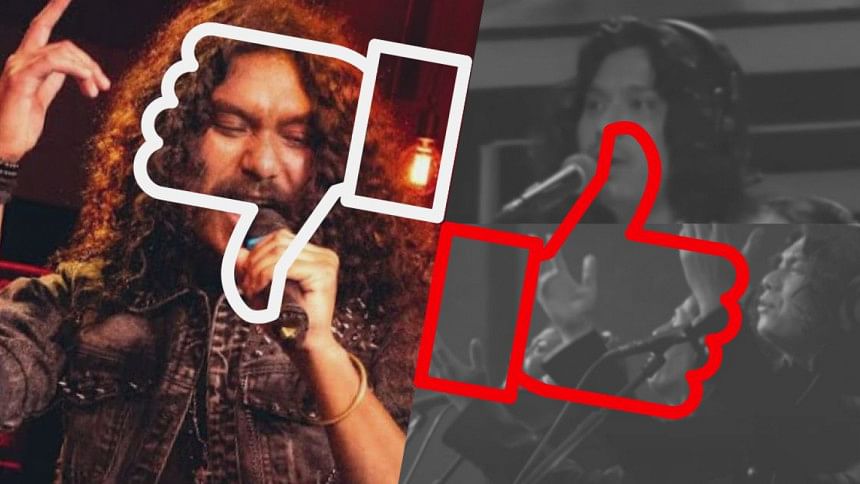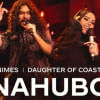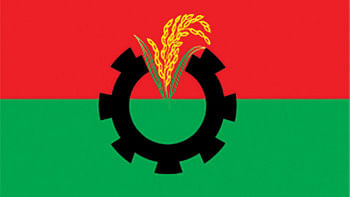A song that exposed our fear of the hybrid

Coke Studio Bangla's latest offering, Nahubo, released on March 18 and featuring a Hajong song by a Hajong singer, sparked a series of debates in both Bangalee and Indigenous communities. The same Hajong singer wrote the song Nasek Nasek, which was released in February 2022 as the inaugural song of the very first season of Coke Studio Bangla, and was adored by Coke Studio followers in Bangladesh and abroad. What made Nasek Nasek so popular, whereas Nahubo received sceptical responses?
Some people would argue that it's because of the quality of music or the taste of individual listeners. Nevertheless, there is a larger politics of identity and nationalism undergirded in the responses that Nasek Nasek and Nahubo each received.
Coke Studio Bharat and Coke Studio Pakistan were named after the respective countries where they were established. However, Coke Studio Bangla was named after the Bangla language. It did not frame itself as Coke Studio Bangladesh. The focus on the language, on the one hand, offered the scope to invite guest artists from India and other countries. On the other hand, it strengthened the long-standing hegemony of Bangla that has historically subsided at least 44 languages spoken by various Indigenous and minoritised communities across the country.
Coke Studio Bangla devised an innovative response to the critique of the "Bangla" vs "Bangladesh" debate. Its first song, Nasek Nasek, featured the talented young, rising singer Animes Roy, who sang an original song written in his native Hajong language. Animes was accompanied by Pantha Kanai, who sang Dol Dol Duluni – a legendary Bangla folk song written and composed by Abdul Latif, who was also the initial composer of Amar Bhaiyer Rokte Rangano Ekushey February. Such a creative hybrid, which upheld the Bangalee tradition as well as gave recognition to the country's Indigenous tradition, unsurprisingly won love from all fronts.
It was interesting to see how the liberal Bangalee nationalist sentiment was happy to see a tokenistic, somewhat strategic representation of indigeneity in Nasek Nasek. This nationalist sentiment can accept indigeneity only to a certain extent, however. It appreciated an Indigenous performance when it appeared in a non-threatening way, in combination with a traditional Bangla folk song. The tokenistic representation of indigeneity was needed to appease the "feel-good" liberal Bangalee nationalist sentiment against the backdrop of a painful national history of using token solidarity in the name of upholding diversity, harmony, and inclusivity since the Chittagong Hill Tracts (CHT) Accord was signed in 1997. The meaningful implementation of the CHT Accord is yet to come to fruition.
When Indigenous music appeared for the second time in the second season of Coke Studio Bangla through Nahubo, mainstream Bangalee followers got uncomfortable for a variety of reasons. For example, in Nahubo, an Indigenous person appeared as the first repeat singer of Coke Studio Bangla, as opposed to other influential and popular Bangalee singers, singing a song written in an Indigenous language. The Indigenous song was combined with a rap verse by Sohana Rahaman (known by her stage name, Daughter of Coastal). The rap was performed not in standard Bangla, but in a Chattogram dialect that is not easily comprehensible by most Bangla speakers.
On top of that, the rap section – in the style of a traditionally hypermasculine and male-dominated genre in South Asia – was performed by a female singer wearing a hijab. She delivered a fierce and bold performance, claiming that she defied the oppressive gendered norms and did not care what society thought of her.
Nasek Nasek describes an Indigenous tradition of gathering in the village chief's house and sowing the first seeds of paddy. However, Nahubo presents something that goes beyond the representation of Indigenous culture and performance of indigeneity. It addresses universal feelings and emotions. The Bangalee nationalist sentiment appreciated an Indigenous performance as long as it performed indigeneity. When the Indigenous performance tried to play the "universal," the Bangalee nationalist sentiment got deeply uncomfortable.
Some raised concerns about the "discomfort" of having to read subtitles to understand a song from Coke Studio Bangla. Their underlying assumption was that Coke Studio Bangla would always feature songs in Bangla that would be easily comprehensible to standard Bangla speakers. Interestingly, Coke Studio's Murir Tin featured three different dialects and languages from Chattogram, Sylhet, and Khulna regions. People who were not familiar with these had to read the subtitles to understand the lyrics. Why did the complaint about having to read subtitles not arise after Murir Tin was released, and why did the subtitles make people uncomfortable specifically in the case of Nahubo? Is it because Murir Tin featured three cis-male Bangalee singers – two of whom performed Bangla rap in a hypermasculine style, and who did not threaten the hegemonic Bangalee nationalist sentiment?
The liberal Bangalee nationalist sentiment did not find it objectionable when Animes was performing as part of a group in Prarthana and singing Nurer Putula Baba Maulana, or when he sang Ora Amar Mukher Kotha Kaira Nite Chay as part of a group in Hey Samalo. A Hajong native singer subscribing to the spiritual or Bangalee nationalist performance, in fact, affirmed the dominance of Bangalee nationalism. Animes was a "good Indigenous person" to both the Bangalee and Indigenous communities because, until then, he fulfilled the need for token representation by the Bangalee community and the much-needed representation for Indigenous communities. Both Bangalee and Indigenous nationalist sentiments felt threatened when Animes claimed Indigenous and Bangalee traditions in a recent Facebook post (which is not available anymore).
In his post, Animes urged the Bangalee audience not to mock his native language. He reflected on his experience of learning Hajong as a first language and then getting exposed to the fact that the state language of his country was different, and it was Bangla. He described his experience of mainly speaking Bangla in his day-to-day life. He claimed, "I am also Bangalee, Bangladeshi." He lamented the fact that the Hajong language does not have an alphabet or a written form. Through his songs, as he mentioned, he tried to preserve the Hajong language. Nahubo is an artistic creation through which he pays tribute to both the Hajong language and the diverse cultures and traditions in Bangladesh.
Animes' now-deleted post also stated, "...we [the Hajong community] know we are Bangalee," which made Indigenous communities deeply uncomfortable. His statements inadvertently exposed the systematic oppression and tremendous pressure that force Indigenous communities to mask their Indigenous identities and subscribe to the hegemonic "Bangaleeness." An Indigenous person must learn how to perform "Bangaleeness" as best as possible to be accepted in the mainstream community and to climb the ladder of professional success.
Nahubo and its singer Animes faced backlashes from two fronts. On the one hand, some Bangalee listeners threw a sea of racist and nationalist remarks at Nahubo on social media because they could not accept an Indigenous performance from an Indigenous singer. On the other hand, Animes' Facebook status attracted critics from some Indigenous communities who blamed him for claiming his "Bangalee" identity and for not recognising Indigenous struggles for self-determination. Since Animes became one of the very few Indigenous celebrities in Bangladesh, he suddenly turned into an object of extreme scrutiny by both communities. The huge burden of representing Indigenous traditions and upholding Indigenous struggles fell on his shoulders. Animes no longer remained a "good Indigenous person" as he could not fulfil the expectations of both Bangalee and Indigenous communities.
The reactions Animes received expose our deep discomfort with hyphenated, mixed, and complicated identities and experiences. We love to put people in rigid boxes without any space for hybridity. Why did Coke Studio Bangla describe Animes as a "Hajong rockstar" when his major area of specialisation is Bangla folk songs? Why did Animes have to feel the pressure to declare that he was also Bangalee? Animes grew up in the Hajong community, but he also learnt Bangla and was immersed in the Bangalee culture from an early age. It is perfectly natural that Animes will go back and forth between his Hajong and other identities, and that he will code-switch as needed. Why do the nationalist sentiments get upset when their strict borders and boundaries are challenged by someone like Animes and his performance?
Perhaps it's time to rethink how we can go beyond our nationalist sentiments and celebrate hyphenated identities, hybrid experiences, and complex struggles.
Nafisa Tanjeem is associate professor at the Department of Interdisciplinary Studies in Worcester State University, US.
Muktasree Chakma is an Indigenous feminist working in the women and Indigenous rights sector internationally.

 For all latest news, follow The Daily Star's Google News channel.
For all latest news, follow The Daily Star's Google News channel. 











Comments